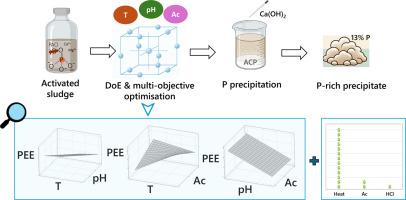针对活性污泥的磷回收策略:DoE和多目标优化,分析关键工艺因素和相关成本
IF 12.4
1区 环境科学与生态学
Q1 ENGINEERING, ENVIRONMENTAL
引用次数: 0
摘要
污水污泥衍生基质已被证明是有希望的磷(P)来源,以减轻对自然保护区的压力。然而,从活性污泥中提取的各种形式的磷使回收具有挑战性,其中磷的释放会限制磷的回收。本研究应用响应面法评估pH、温度、醋酸盐及其相互作用对磷释放的影响,然后进行多目标优化,以确定在最小化提取成本和最大化磷释放之间实现最佳权衡的工艺条件。结果表明,影响磷释放最显著的因素是pH,其次是温度与乙酸盐的交互作用,最后是温度单独作用。与生物酸化或温和加热相比,在pH 4和室温下进行酸化,有效提取磷的操作成本最低(约1美元/公斤Pext)(44%)。提取后,磷被成功地沉淀为ACP(在pH 9下沉淀效率为100%),每吨污泥(干物质)可回收15-20千克磷。本文章由计算机程序翻译,如有差异,请以英文原文为准。

Targeting phosphorus recovery strategies for activated sludge: DoE and multi-objective optimisation to analyse key process factors and associated costs
Sewage sludge-derived matrices have been shown to be promising sources of phosphorus (P) to alleviate pressure on natural reserves. However, the diverse forms of P to be extracted from activated sludge make recovery challenging, where P release can limit P recovery. This study applies response surface methodology to evaluate the effects of pH, temperature, acetate, and their interactions, on P release, followed by multi-objective optimisation to identify the process conditions that achieve the optimal trade-off between minimising extraction costs and maximising P release. Results indicated that the most significant factors impacting P release were pH, followed by the interaction between temperature and acetate, and temperature alone. Acidification at pH 4 and room temperature achieved the lowest operational costs (∼ 1 US$/kg Pext) for effective P extraction (44%), as compared to bioacidification or mild heating. Following extraction, P was successfully precipitated as ACP (∼ 100% precipitation efficiency at pH 9), enabling a potential recovery of 15-20 kg P per tonne of sludge (dry matter).
求助全文
通过发布文献求助,成功后即可免费获取论文全文。
去求助
来源期刊

Water Research
环境科学-工程:环境
CiteScore
20.80
自引率
9.40%
发文量
1307
审稿时长
38 days
期刊介绍:
Water Research, along with its open access companion journal Water Research X, serves as a platform for publishing original research papers covering various aspects of the science and technology related to the anthropogenic water cycle, water quality, and its management worldwide. The audience targeted by the journal comprises biologists, chemical engineers, chemists, civil engineers, environmental engineers, limnologists, and microbiologists. The scope of the journal include:
•Treatment processes for water and wastewaters (municipal, agricultural, industrial, and on-site treatment), including resource recovery and residuals management;
•Urban hydrology including sewer systems, stormwater management, and green infrastructure;
•Drinking water treatment and distribution;
•Potable and non-potable water reuse;
•Sanitation, public health, and risk assessment;
•Anaerobic digestion, solid and hazardous waste management, including source characterization and the effects and control of leachates and gaseous emissions;
•Contaminants (chemical, microbial, anthropogenic particles such as nanoparticles or microplastics) and related water quality sensing, monitoring, fate, and assessment;
•Anthropogenic impacts on inland, tidal, coastal and urban waters, focusing on surface and ground waters, and point and non-point sources of pollution;
•Environmental restoration, linked to surface water, groundwater and groundwater remediation;
•Analysis of the interfaces between sediments and water, and between water and atmosphere, focusing specifically on anthropogenic impacts;
•Mathematical modelling, systems analysis, machine learning, and beneficial use of big data related to the anthropogenic water cycle;
•Socio-economic, policy, and regulations studies.
 求助内容:
求助内容: 应助结果提醒方式:
应助结果提醒方式:


